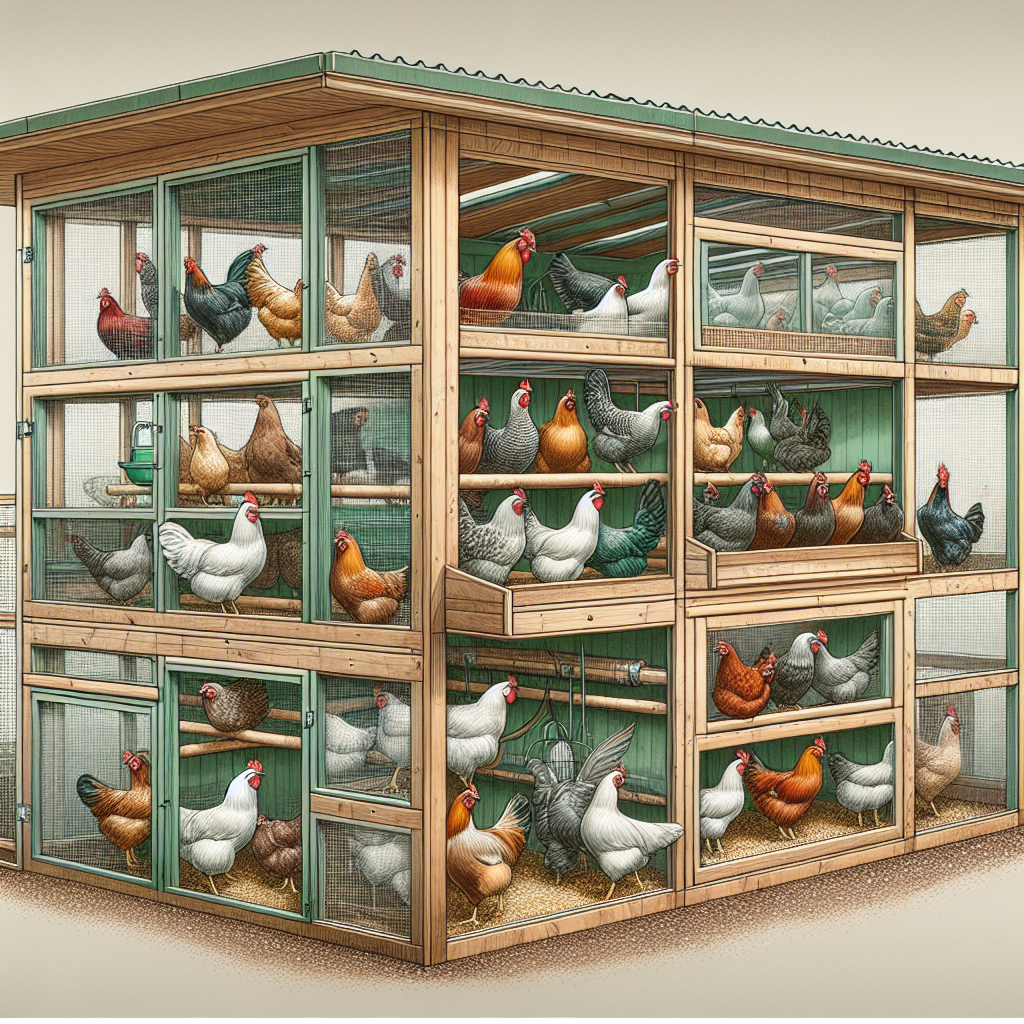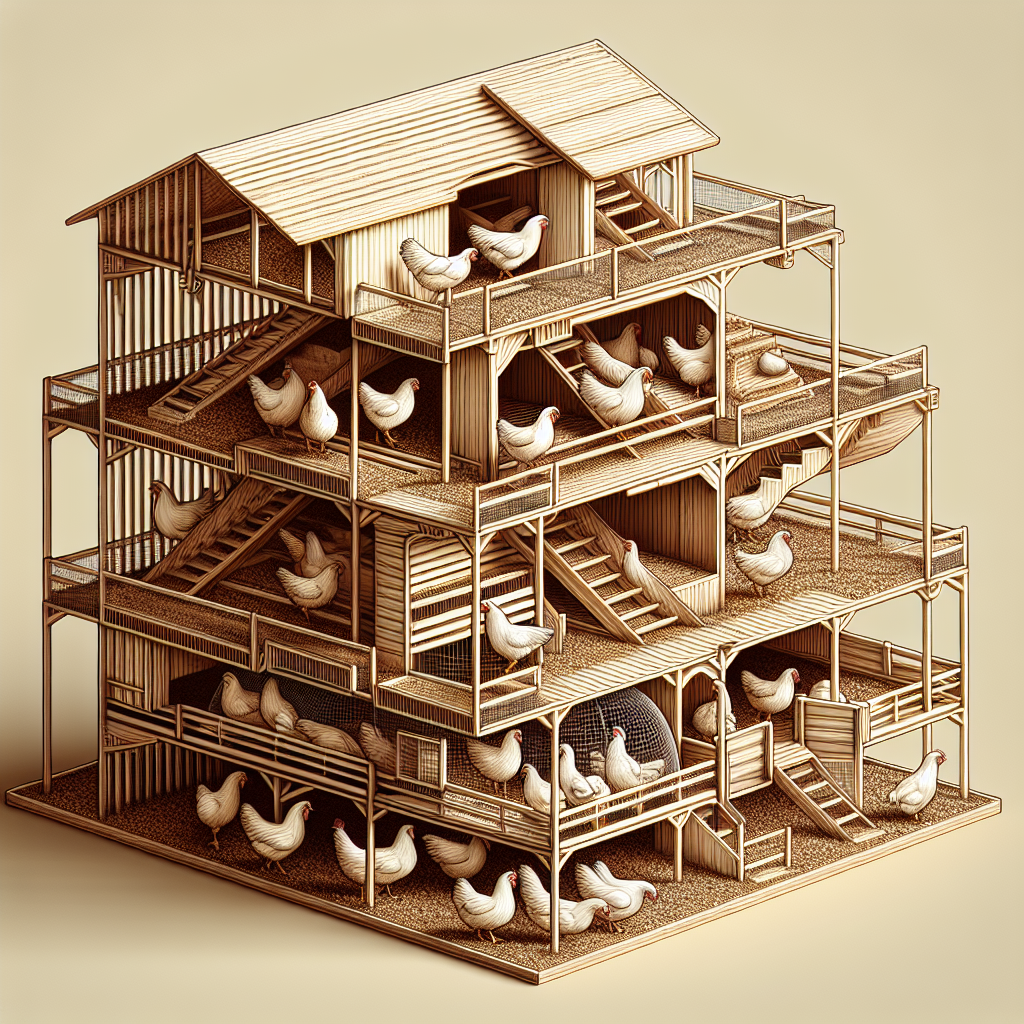Imagine you’re a chicken farmer, eager to maximize your flock’s egg production and overall productivity. But have you ever wondered how the design of your chicken coop can impact these factors? Well, you’re in luck! In this article, we will be exploring the fascinating world of coop designs and their influence on egg laying and productivity in chickens. Get ready to discover the secrets behind creating the perfect coop environment for your feathered friends.
Coop Design Factors
When it comes to raising chickens, creating an optimal coop design is crucial for ensuring the well-being and productivity of your flock. A well-designed coop not only provides a safe and comfortable environment for your chickens, but it also plays a significant role in influencing their egg laying and overall productivity. Several factors need to be taken into consideration when designing a coop, including space allocation, lighting, ventilation, nesting boxes, roosting bars, flooring, security and protection, access to food and water, and the social environment. In this comprehensive article, we will explore each of these factors and provide insights on how they impact the egg laying and overall productivity of chickens.
Space Allocation
The first factor to consider when designing a coop is space allocation. Chickens require adequate space to move around freely and engage in their natural behaviors. Insufficient space can lead to stress, overcrowding, and territorial disputes, which may negatively affect egg production. When determining the total area of the coop, it is recommended to provide at least 4 square feet per chicken. This includes both indoor and outdoor space.
Indoor Space
The indoor space of the coop should offer enough room for the chickens to move around comfortably. It should be well-ventilated and provide protection from extreme weather conditions. The indoor space should include perches for chickens to rest and roosting bars for sleeping. Additionally, nesting boxes should be strategically placed within the coop to encourage productive egg laying.
Outdoor Space
Outdoor space is vital for the overall well-being of chickens. It allows them to exercise, forage for food, and soak up sunlight. Outdoor access provides a diverse environment, which can positively influence the nutritional profile of the eggs produced. Furthermore, chickens that have access to outdoor space are generally happier and more content, leading to increased productivity.
Perch Space
Perches are essential for chickens to rest and sleep comfortably. The coop should include perches of suitable size and height to accommodate the flock. The perches should be spaced adequately to prevent overcrowding and dominance disputes among the chickens.
Nesting Space
Nesting boxes should be designed to provide comfort and privacy for the hens to lay their eggs. The number of nesting boxes should be proportional to the number of hens in the flock. The size of the nesting boxes should be spacious enough for chickens to enter, move around, and lay their eggs comfortably.
Lighting
Lighting plays a critical role in the egg-laying patterns and overall productivity of chickens. The natural circadian rhythm of chickens is heavily influenced by light. Adequate lighting ensures healthy growth and development, as well as optimum egg production.
Natural Light
Natural light is an essential component of a well-designed chicken coop. Exposure to natural sunlight allows for the synthesis of vitamin D, which is crucial for eggshell quality and overall reproductive health. To maximize natural light, the coop should have windows or skylights strategically placed to allow sunlight to enter.
Artificial Lighting
In situations where natural light is limited, supplemental artificial lighting can be used to ensure adequate lighting duration. The use of artificial lighting should mimic natural daylight patterns and provide a consistent duration of light throughout the day. A timer can be used to regulate the artificial lighting, ensuring that the chickens receive a minimum of 14-16 hours of light per day.
Light Intensity
The intensity of light within the coop should be sufficient for the chickens to see clearly and engage in their natural behaviors. Proper lighting intensity helps reduce stress and encourages healthy egg production. Dim lighting or excessively bright lighting can disrupt the natural rhythm of the chickens, leading to decreased egg production.
Light Duration
The duration of light plays a critical role in regulating the egg-laying cycle of chickens. Increasing the light duration during the winter months can help maintain consistent egg production. It is essential to gradually adjust the lighting duration to prevent sudden changes that may stress the chickens.
Ventilation
Proper ventilation is vital for maintaining a healthy and productive coop environment. Adequate air circulation, humidity control, and temperature management are essential components of a well-ventilated coop.
Air Circulation
Fresh air is crucial for the well-being of chickens. Good air circulation helps remove excess moisture, ammonia, and other airborne particulates, promoting a healthier environment. Ventilation openings should be strategically placed to ensure proper airflow without causing drafts that may lead to temperature fluctuations.
Humidity Control
Excessive humidity within the coop can lead to respiratory issues and the growth of harmful bacteria. Proper ventilation helps regulate humidity levels by removing moisture from the coop. Ventilation openings should be designed to prevent rainwater from entering, while ensuring proper airflow.
Temperature Management
Fluctuations in temperature can be detrimental to egg production and overall chicken health. A well-ventilated coop helps maintain consistent temperatures, preventing heat stress in the summer and cold drafts in the winter. Proper insulation and ventilation placement are key to achieving optimal temperature management within the coop.
Nesting Boxes
Nesting boxes are essential for encouraging productive egg-laying behavior in chickens. Their design and placement play a significant role in the comfort and privacy of the hens.
Number of Boxes
The number of nesting boxes should be appropriate for the size of the flock. As a general guideline, there should be one nesting box for every 3-4 hens. Providing an adequate number of nesting boxes prevents overcrowding and reduces the likelihood of hens laying eggs in undesirable locations within the coop.
Box Size
Nesting boxes should be spacious enough for the hens to comfortably enter and move around. The dimensions should be approximately 12-14 inches wide, 12-14 inches deep, and 12-14 inches tall. A suitable-sized nesting box allows the hens to assume a natural nesting position, ensuring their comfort while laying eggs.
Comfort and Privacy
Nesting boxes should provide a cozy and secluded environment for hens to lay their eggs. The boxes should be lined with suitable bedding, such as straw or shavings, to mimic the natural nesting materials that chickens prefer. Providing a quiet and dark nesting area helps reduce stress and disturbances, resulting in more consistent and productive egg laying.
Roosting Bars
Roosting bars are essential for chickens to rest and sleep comfortably. Their design and placement should be considered when designing a coop.
Size and Height
Roosting bars should be designed to accommodate the size and weight of the chickens in the flock. A suitable diameter for the bars is approximately 1.5-2 inches. The height of the bars should be set at a level that allows the chickens to comfortably roost without their heads touching the ceiling of the coop.
Spacing
The spacing between roosting bars should be adequate to prevent overcrowding or dominance disputes among the chickens. A spacing of approximately 8-12 inches between bars allows the chickens to perch comfortably without feeling cramped or restricted.
Comfort
Roosting bars should be designed to provide a comfortable resting area for chickens. Smooth and rounded edges prevent discomfort or injuries to the chickens’ feet. Offering a variety of heights and textures in the roosting bars encourages the chickens to utilize different levels, promoting natural behaviors and reducing the likelihood of aggression.
Flooring
The type of flooring used within the coop plays a significant role in hygiene, cleanliness, and the overall health of the chickens.
Type of Flooring
Choosing the right flooring material is crucial for maintaining a clean and healthy coop environment. Common options include concrete, wood, or wire mesh. Concrete flooring is easy to clean but can be hard on the chickens’ feet. Wood flooring provides insulation but requires regular maintenance to prevent moisture buildup. Wire mesh flooring allows droppings to fall through, keeping the coop cleaner, but it may cause discomfort to the chickens’ feet if not properly designed.
Cleanliness and Maintenance
Regardless of the type of flooring chosen, maintaining cleanliness is essential for the health and productivity of the flock. Regular cleaning and disinfection of the coop floor help prevent the buildup of harmful bacteria and parasites. Implementing a proper waste management system, such as a removable droppings tray or deep litter method, helps keep the coop clean and reduces the chances of disease transmission.
Security and Protection
Creating a secure and protected environment is vital for the safety and well-being of your chickens. Protecting them from predators and inclement weather ensures their overall productivity.
Predator Prevention
Coop design should incorporate measures to protect chickens from predators such as raccoons, foxes, and snakes. Reinforced wire mesh or hardware cloth should be used to enclose the entire coop, including the roof, floor, and openings. Digging barriers can also be implemented to prevent predators from burrowing beneath the coop.
Protection from Inclement Weather
The coop should be designed to shield chickens from extreme weather conditions such as rain, wind, and excessive sunlight. Adequate roofing materials, such as metal or shingles, should be used to prevent leaks and ensure proper drainage. Windbreakers or shades can be installed to protect chickens from strong winds or excessive sunlight. Proper insulation and ventilation are crucial for maintaining a comfortable temperature within the coop during extreme weather conditions.
Access to Food and Water
Providing easy access to food and water is essential for maintaining the health and productivity of your flock.
Availability and Placement
Food and water should be readily available to all chickens within the coop. Placing multiple feeding and watering stations throughout the coop prevents overcrowding and dominance disputes. Easy access to food and water encourages consistent feed intake and hydration, ensuring optimal egg production and overall health.
Feeder and Waterer Design
Feeder and waterer design should be practical, easy to clean, and prevent spillage or contamination. Various options, such as hanging feeders, treadle feeders, or automatic feeders, can be considered depending on the size and needs of the flock. Waterers should be designed to prevent spillage and provide a clean source of water. Regular cleaning and refilling of feeders and waterers are essential to maintain hygiene and prevent bacterial growth.
Social Environment
The social environment within the coop impacts the overall well-being and productivity of the chickens. Establishing an optimal social structure and promoting positive interactions among the flock is crucial.
Flock Size
The size of the flock should be carefully considered when designing a coop. Overcrowding can lead to stress, aggression, and territorial disputes, which negatively impact egg production and overall flock dynamics. A suitable flock size ensures that each chicken has ample space and resources, promoting a harmonious social environment.
Pecking Order Dynamics
Chickens have a natural pecking order, which establishes a hierarchy within the flock. Designing the coop to include multiple perches, hiding spots, and corners helps chickens establish their social positions without excessive aggression. Providing distractions, such as hanging toys or treats, encourages positive interactions and reduces boredom-related issues.
In conclusion, coop design factors have a significant influence on the egg laying and overall productivity of chickens. By carefully considering and implementing factors such as space allocation, lighting, ventilation, nesting boxes, roosting bars, flooring, security and protection, access to food and water, and the social environment, you can create an optimal environment for your flock. A well-designed coop ensures the comfort, health, and happiness of your chickens, leading to increased egg production and overall productivity. When designing your coop, always prioritize the well-being of your feathered friends and provide them with the best possible environment to thrive.




